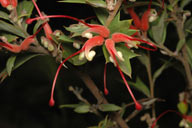In Flower This Week
A news sheet prepared by a Gardens' volunteer.
Numbers before each plant refer to temporary IFTW labels in the gardens.
Numbers in square brackets [ ] refer to garden bed Sections. Plants in flower are in bold type.
View past issues of 'In Flower This Week'.
5 August 2015
Grevillea tripartita subsp. macrostylis click for larger image |
Today we will walk along the Main Path to see the winter-flowering banksias and grevilleas.
- Cross the bridge and skirt past the café to see on your left Correa bauerlenii [Section 244] with long green bell flowers and shiny foliage. The calyx has an expanded base which looks like a chef's hat, resulting in the shrub's common name, Chef's Cap Correa. It is endemic to southern coastal New South Wales.
- Further on the left is Banksia ‘Stumpy Gold’ [Section 131], with fine, toothed linear foliage and short gold flowering cones. This plant is a dwarf cultivar of Banksia spinulosa var. collina.
- Also on your left is Banksia spinulosa var. collina [Section 131], with fine linear foliage and slender, dull gold cones. This shrub, commonly known as Hill Banksia or Golden Candlesticks, grows along the east coast of Australia in Queensland and New South Wales.
- Turn left up the hill and continue along the path to see on the right Grevillea acropogon [Section 30], a low bush with green foliage and deep red clusters of flower. It is endemic to southwestern Western Australia and is threatened in the wild.
- On your left is Banksia spinulosa var. neoanglica [Section 25], or New England Banksia, with silver-backed dark green foliage with yellow/gold upright cones. It is a shrub that grows along the east coast of Queensland and New South Wales.
- Also on your left is Grevillea rhyolitica subsp. rhyolitica [Section 25], or Deua Grevillea, endemic to the south coast of New South Wales. It is a small to medium-sized shrub with coral red spider flowers.
- On the right [Section 26] and also on your left [Section 24] is Grevillea ‘Lady O’. It is a long-blooming shrub with red flowers and bright green foliage. A hybrid between Grevillea victoriae and G. rhyolitica, it was developed by local plant breeder Peter Ollerenshaw and named for his mother.
- On your right is Banksia ‘Cape Patterson Dwarf’ [Section 26], a small bush with silver-backed dark green foliage and lime-yellow cones.
- Further on your right is Grevillea lavandulacea [Section 26], commonly known as Lavender Grevillea, endemic to south-eastern South Australia and western and central Victoria. The shrub shows off a pleasing contrast between the grey foliage and dark red flowers.
- Again on your right is Grevillea centristigma [Section 26], a small bush with soft lush foliage fringed with white hairs. Pendent hard yellow/orange flowers open from greenish buds. It is endemic to the south west region of Western Australia.
- On your right behind the seat is Grevillea tripartita subsp. macrostylis [Section 26], an open, rangy plant with dark green, prickly, three-lobed foliage and large single red and cream flowers with long showy red styles. It is native to southern Western Australia.
- Still on your right low down is Isopogon asper [Section 26], a shrub that is endemic to the southwest botanical province of Western Australia, first described by botanist Robert Brown in 1830. It is a small shrub with daisy-like yellow flowers with pink centres aging to pink.
- Grevillea ripicola [Section 24], on the left, commonly known as Collie Grevillea, is a shrub endemic to south-west Western Australia. It forms a dense bush with large yellow spider flowers with red styles.
- On your right is a member of the Grevillea haplantha group [Section 26], a spindly bush with linear foliage and large red spider flowers with long styles.
- Grevillea wilsonii x tripartita [Section 26], is on your right, a tall, rangy bush with prickly foliage and large pink spider flowers with red styles.
Rosalind Walcott
![Director of National Parks [logo]](../../../../images/dnp_90px.gif)







